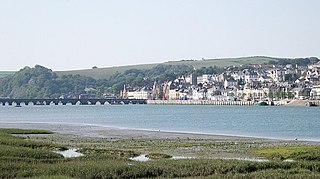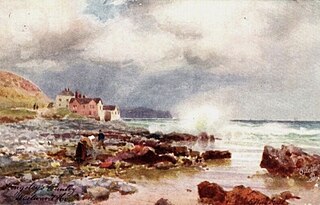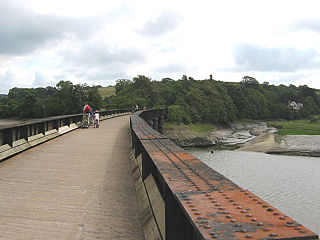
Bideford is a historic port town on the estuary of the River Torridge in north Devon, south-west England. It is the main town of the Torridge local government district.

The United Services College was an English boys' public school for the sons of military officers and civil servants, located from 1874 at Westward Ho! near Bideford in North Devon, from 1904 at Harpenden, Hertfordshire, and finally at Windsor, Berkshire. Almost all boys were boarders. The school was founded to prepare pupils for a career as officers in the armed services, many of them going on to the Royal Military College, Sandhurst, or the Royal Naval College, Dartmouth.

Braunton is a large village, civil parish, ecclesiastical parish and former manor in Devon. The village is situated 5 miles (8 km) west of Barnstaple. It is one of the largest villages in Devon with a population at the 2021 census of 10,217 people. There are two electoral wards. Their joint population at the above census was 8,218. Within the parish is the fertile, low-lying Braunton Great Field, which adjoins the undulating Braunton Burrows, the Core Area in North Devon Biosphere Reserve, the largest psammosere in England. It confronts the Atlantic Ocean at the west of the parish at the large beach of Saunton Sands, one of the South West's international-standard surfing beaches.

Northam is a market town, civil parish and electoral ward in Devon, England, lying north of Bideford. The civil parish also includes the villages of Westward Ho!, Appledore, West Appledore, Diddywell, Buckleigh and Silford, and the residential areas of Orchard Hill and Raleigh Estate.

Appledore is a village at the mouth of the River Torridge, about 6 miles (10 km) west of Barnstaple and about 3 miles (5 km) north of Bideford in the county of Devon, England. It is the home of Appledore Shipbuilders, a lifeboat slipway and Hocking's Ice Cream, a brand of ice cream only sold in North Devon. There are numerous shops, cafes and galleries. The local football club is Appledore F.C. The ward population at the 2011 census increased to 2,814.

Clovelly is a privately owned harbour village in the Torridge district of Devon, England. The settlement and surrounding land belongs to John Rous who inherited it from his mother in 1983. He belongs to the Hamlyn family who have managed the village since 1738.

Instow is a village in north Devon, England. It is on the estuary where the rivers Taw and Torridge meet, between the villages of Westleigh and Yelland and on the opposite bank to Appledore. There is an electoral ward with the same name. The ward's total population at the 2011 census was 1,501.

The Tarka Trail is a series of footpaths and cyclepaths around north Devon, England that follow the route taken by the fictional Tarka the Otter in the book of that name. It covers a total of 180 miles (290 km) in a figure-of-eight route, centred on Barnstaple.

Abbotsham is a village and civil parish in the English county of Devon. In 2001 its population was 434 increasing at the 2011 census to 489.

The Bideford, Westward Ho! and Appledore Railway was a railway running in northwest Devon, England. It is unusual in that although it was built as a standard gauge 4 ft 8+1⁄2 in line, it was not joined to the rest of the British railway network, despite the London and South Western Railway having a station at Bideford East-the-Water, just on the other side of the river Torridge from the main town. The line was wholly situated on the peninsula made up of Westward Ho!, Northam and Appledore with extensive sand dunes by the Torridge and Taw estuary. The line opened in stages between 1901 and 1908, but closed in 1917, having been requisitioned by the War Office. Re-opening the line after World War I was considered, but dismissed as a viable option. The B.WH!&A.R. was the only railway company in the British Isles to have an exclamation mark in its company title.

The North Devon Football League is a football competition based in England, established in 1904. The top division of this league, the Premier Division, operates at level 12 of the English football league system and has been a feeder to the Devon Football League since 2019, and previously, the South West Peninsula League. The North Devon Gazette sponsors the league and so the full, sponsored name of the league is the North Devon Gazette Football League.

The North Devon Coast is a designated Area of Outstanding Natural Beauty in Devon, England, designated in September 1959. The AONB contributes to a family of protected landscapes in the Southwest of England and a total of 38% of the region is classified by the International Union for Conservation of Nature as Category V Protected Landscapes. The twelve Areas of Outstanding Natural Beauty extend to 30% of the region, twice the proportion covered by AONBs in England as a whole and a further two National Parks, Dartmoor and Exmoor, cover an additional 7%.

Westward Ho! railway station was a railway station in north Devon, north-west of Bideford, serving the village of Westward Ho!; a tourist community within the parish of Bideford.

Northam railway station was a railway station on the Bideford, Westward Ho! and Appledore Railway in north Devon, close to Appledore. The station served the village of Northam, Parish of Northam, a community within the Appledore peninsula. It was 5 miles 45 chains from Bideford.

Bideford Bay, also known as Barnstaple Bay and often shown on maps as Barnstaple or Bideford Bay, is a large area of water on the northwest coast of Devon in South West England, at the southwestern end of the Bristol Channel where it joins the Celtic Sea. The bay extends from Hartland Point in the southwest to Baggy point the northeast, and is partly sheltered by the island of Lundy, 12 miles (19 km) offshore. It takes its alternative names from the towns of Bideford and Barnstaple, located respectively on the rivers Torridge and Taw which flow into the bay. The alternative spelling Barnstable Bay, in use long after that spelling became obsolete for the town, is also sometimes seen.

Lovers' Lane Halt railway station was a minor railway station or halt in north Devon close to the town of Appledore, a community lying on the peninsula formed by the sea, the River Torridge, and the River Taw.

Richmond Road Halt was a minor railway station or halt in north Devon, situated fairly close to the town of Appledore, a community lying on the peninsula formed by the sea, the River Torridge, and the River Taw.

Cornborough railway station was a minor railway station or halt/request stop in north Devon, close to Westward Ho!, serving holiday makers visiting the cliff walks and nearby beach. It lay 3 miles and 30 chains from Bideford Quay.

North Devon's Biosphere Reserve is a UNESCO biosphere reserve in North Devon. It covers 55 square miles (140 km2) and is centred on Braunton Burrows, the largest sand dune system (psammosere) in England. The boundaries of the reserve follow the edges of the conjoined catchment basin of the Rivers Taw and the Torridge and stretch out to sea to include the island of Lundy. The biosphere reserve is primarily lowland farmland, and includes many protected sites including 63 Sites of Special Scientific Interest which protect habitats such as culm grassland and broadleaved woodlands. The most populous settlements in its buffer area are Barnstaple, Bideford, Northam, Ilfracombe, and Okehampton.





















